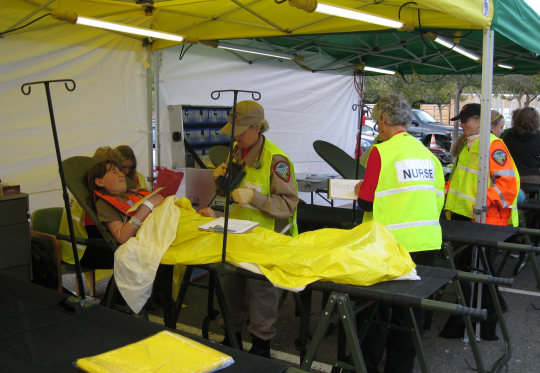Volume 8, No. 1 February 21, 2012
In Brief...
Prior Issues...
- 2008
- 2007
- 2006
- 2005
- 2014
- 2013
- 2012
- 2011
- 2010
- 2009
PDF Archives
- 2000
- 1999
- 1998
- CC Bulletin Supplements
- 2005
- 2004
- 2003
- 2002
- 2001
Medical Reserve Corps Marks 10th Anniversary in 2012

MRC volunteers participating in surge tent training.
The network of MRC volunteers includes medical and public health professionals who provide health care and education to community members, as well as non-medical volunteers who provide leadership, logistic and other support. MRC units are community-based and are developed to meet the local needs. MRC units initiate and participate in public health activities throughout the year - ranging from flu vaccination clinics and smoking cessation initiatives to disease prevention through programs like the “Million Hearts” and “Let’s Move” campaigns. Not only are these prevention activities important to individual community members; they help to lessen the susceptibilities and vulnerabilities that raise disaster risk profiles for communities.
Medical Reserve Corps volunteers also train with local emergency response partners, and participate in drills and exercise, to ensure that all are familiar with each other and know their response roles and responsibilities. MRC volunteers are typically given assignments during an emergency that support local health departments, emergency agencies, shelters, hospitals, points of dispensing, and other community agencies. Over the past decade, MRC units have demonstrated a phenomenal ability to enhance the resiliency of their communities and expand response capabilities by assisting in disasters such as the Alabama tornadoes, Midwest flooding events, the Gulf Coast Horizon Oil Spill, Hurricanes Ike and Gustav in 2008, the Southern California wildfires, and Hurricanes Katrina and Rita in 2005.
The Division of the Civilian Volunteer Medical Reserve Corps (DCVMRC) is headquartered in the Office of the Surgeon General and functions as a clearinghouse for information and best practices to help communities establish, implement, and maintain Medical Reserve Corps units nationwide. The DCVMRC is led by Captain Rob Tosatto, a U.S. Public Health Service Commissioned Corps officer since 1988, and a recognized leader in the realm of emergency preparedness and response. CAPT Tosatto sees a clear connection between the MRC and the U.S. Public Health Service (USPHS) at the national level and continuing through the regional and local levels. He says that “the MRC has always had clear direction from the Surgeon General. In fact, we have encouraged MRC members and leaders to consider themselves as ambassadors of the Surgeon General in their local communities. They can take the broad public health priorities and help to implement them at the grassroots level.” He adds that there are “tremendous synergies with the USPHS Commissioned Corps. USPHS officers can support the MRC efforts in the communities where they live and work. Furthermore, Corps officers might find themselves working side-by-side with local MRC members during deployments.”
To prepare for and support this integration, members of the MRC and Commissioned Corps have trained and worked alongside each other over the past few summers:
- In 2011, “Operation Lone Star” was a field training that provided free medical, behavioral health and social services to thousands of vulnerable community members.
- In 2010, MRC volunteers collaborated with USPHS officers during a Remote Area Medical event at the Oklahoma State Fairgrounds. The free healthcare weekend provided over 1,600 individuals - who would not otherwise be able to afford it - with quality dental, vision and general medical care.
- In 2009, the Office of Force Readiness and Deployment (OFRD) invited over 100 MRC members to participate in the field trainings and exercises at Fort AP Hill, Virginia. A wide range of topics essential for deploying to disaster areas were covered, including triage, water and food safety, mental health assessment, patient transport, and animal control. At the end of the training, they were challenged to successfully respond to a simulated disaster occurring in a community suffering from a severe H1N1 outbreak.



